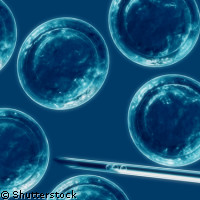Europe's stem cell scientists report on progress
'Stem cells are remarkable cells. They open up some very important possibilities in biomedical research,' said Professor Austin Smith of the University of Cambridge at a conference on stem cell research in Europe, organised by the EU-funded EuroStemCell project. These possibilities include the chance to understand cell development and disease processes, screen for drug targets, test drugs and much more. 'The major application for the foreseeable future is going to be in drug screening and drug discovery,' commented Professor Smith. Another exciting possibility offered by stem cells lies in transplanting stem cells into patients. However, scientists who develop such therapies often face considerable difficulties in gaining approval for clinical trials. Work done by the EuroStemCell consortium on muscular dystrophy offers a good example of this problem. Duchenne Muscular dystrophy (DMD) is a genetic disease which affects muscle formation. Those affected become progressively weaker over time as their muscles break down and few patients survive beyond their twenties. Mesangioblasts are cells found in our blood vessels and are responsible for muscle repair. Margaret Buckingham of the Pasteur Institute in France explained how EuroStemCell scientists had succeeded in extracting these cells from golden retrievers suffering from a disease similar to human muscular dystrophy. They then grew the cells in culture and genetically modified them to correct the mutation which causes DMD. They injected the modified cells into the bloodstream where they went to the damaged muscles and repaired them. Because the genetically modified cells did not contain the full dystrophin gene, the best results came from dogs who had received stem cells from healthy donors. The researchers have also been able to isolate mesangioblasts from humans and grow them in the lab. When injected into mice with muscular dystrophy, these healthy human cells repaired the mice's damaged muscles and made them stronger. The next logical step is to test this therapy in humans. However, as Giulio Cossu of the Stem Cell Research Institute in Milan, Italy, pointed out, the project partners have faced a number of barriers to carrying out these trials. Research funding organisations are cautious of giving money to the first trial of an innovative therapy which, if it went wrong, would be disastrous for the field. The researchers also encountered opposition from clinicians, who are used to the concept of testing drugs but are unused to the concept of testing cells. Professor Cossu recommended getting clinicians involved in the research early on, so that they can see for themselves the effect of the therapy in animal models. Meanwhile patient groups are often too willing to take risks with new therapies. As one conference participant pointed out, having muscular dystrophy is already a disaster for those affected as it is always fatal and there is currently no cure. From their point of view, they have little to lose and a lot to gain. This underlines the need to educate patient groups who are often frustrated by the complex regulations surrounding clinical trials. The International Society for Stem Cell Research (ISSCR) has set up a Task Force on Clinical Translation of Stem Cells to address these issues, and many EuroStemCell partners are involved in its work. The EuroStemCell project is now drawing to a close, and Octavi Quintana Trias of the European Commission congratulated it for its efforts over the past four years. 'This is a successful project,' he said, noting that it had produced around 60 publications in leading journals, filed 20 patents, covered a wide range of disciplines and involved small and medium sized enterprises (SMEs) as well as academic researchers. 'This is what we would like to have for most projects,' added Mr Quintana Trias.



